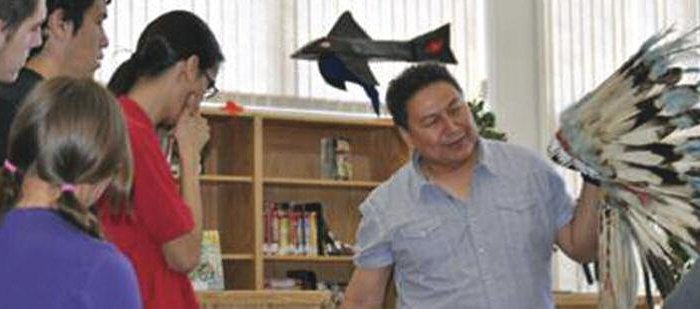Students go digital as part of Treaty Learning

Related Programs
Students from Balcarres learned that the art of film, audio and digital photography can create a fascinating opportunity to learn about Treaties in Saskatchewan.
In 2010, the students were given the opportunity to interview and record conversations with community members, including high profile First Nations Leaders on the Treaties and their impact in the province. Students were then able to utilize this knowledge and create a documentary film on their findings. They worked under the guidance of project leaders, Nicole Strandlund, Michele Schwab, Ali Matai, David Racette, and Chrysa Peterson.
“We were looking for an opportunity to use the arts to raise awareness of what Treaty means,” explains Larry Strandlund, vice principal and art teacher at Balcarres High School. “The TreatySmarts grant provided us with the opportunity to get the expertise required for this multitiered, multi-media approach.”
To begin, the students formed three production teams that each had individuals responsible for interviewing, audio and filming. Saskatchewan documentary film artist, Angela Mae Edmunds, helped the students learn interview skills, such as how to formulate questions and put people at ease during the interview. “They even practiced the interview process, interviewing each other on video,” explains Strandlund. “Then they critiqued the videos, discussing things such as how well different shots, lighting options and camera angles had worked and what they could do better.” Along with interview and videography skills, the students also learned from First Nations Liaison Officer Rose Alma Bellegarde, the proper protocol for working with First Nations elders.
When they were ready, the students met with individuals such as Chief Perry Bellegarde of Little Bear First Nation, Chief Michael Starr of Starblanket First Nation, Chief Mary Anne DayWalker- Pelletier of Okanese First Nation, Dan Bellegarde, knowledge-keeper Wendall Starr, Barry Tuckanow, Martine Desnomie and Frieda Koochicum.
“This opportunity enabled us to put a face on treaty knowledge,” remarks Strandlund. “The students were astounded by the knowledge in the community. Some of the students did not have much experience working with elders. They were bowled over by the knowledge of these people and amazed at their willingness to spend time sharing their knowledge.”
After completing the interviews, the learning continued. Edmunds worked with them to create the documentaries. “Students had to have a lot of patience,” he says, “as they worked with teachers through several software difficulties. At one point, their work disappeared, but in the end, they managed to piece a product together.” Other students, who had taken still photographs at each of the interviews, worked to create Role model posters as part of another project that ran in conjunction with the Treaty project.
The work was screened at a gala event held June 2011 that was open to students from the entire school. “Those community members that were interviewed and featured in the film were invited to attend and participate in a panel,” Strandlund says. “After viewing the documentary, students had the opportunity to ask the panel questions about what they had learned.” As well as the Role model posters, the event also featured an exhibition of the Grade 7-9 paintings based on Treaties and how they are very much alive today. Artists Cristian Barreno and Maurice Louison helped these students express their vision of Treaties through visual art. Besides seeing the works, visitors attending the gala could also view a computer-projected display featuring interviews of the students talking about their work, including different aspects of the paintings and their understanding of Treaty.
The entire experience had a lasting impact on the school. “It left us with expertise in documentary film-making, photography and visual art, several tools for teaching future students about Treaty, and equipment such as cameras, lighting and digital recording devices, which have been incorporated into the arts program.” The school is already preparing for another project where a partnership with SIAST will enable the students to explore photography in more detail, as well as add a more literary focus to the Role model poster concept.
Perhaps more importantly, “This was a wonderful opportunity for the entire school to work together on a project, learn new skills and learn about Treaties,” explains Strandlund. “It created a positive connection between students and community.”
TreatySmarts, which receives funding from SaskCulture and Saskatchewan Lotteries Trust Fund for Sport, Culture and Recreation, is offered through the Saskatchewan Arts Board. This program is part of ArtSmarts, which enables student, teacher and artist collaborations, focuses on inquiry learning which encourages students to develop their own questions, learning methods and ideas. For more information, contact Dianne Warren at (306) 787.4659 or email: dianne@artsboard.sk.ca.

